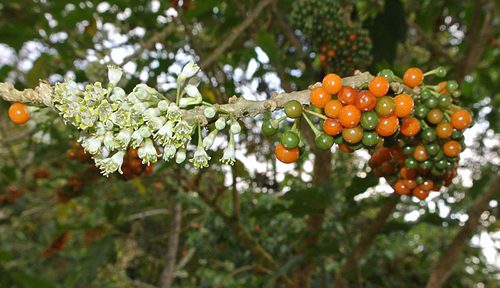Thrush fruit (Iochroma arborescens, formerly Acnistus arborescens) is a small tree known for its ornamental flowering and fruiting, playing a significant ecological role. Its fruits provide food for a wide variety of wild birds, including the thrush (Turdus rufiventris). The tree reaches a bushy or small tree stature, rarely exceeding 33 feet (10 meters) in height. It features thin, branched limbs with light and fragile wood.
The leaves are simple, alternate, elliptical to lanceolate, with the upper page glabrous and the lower slightly tomentose. Flowers can appear throughout the year, especially in spring and summer. With a tubular and bell-shaped form, fragrant and white, they cluster in fascicle-type inflorescences along mature branches, in leafless spaces.
Pollination occurs through a wide variety of insects and birds, ranging from flies to beetles, moths, bees, and hummingbirds. The resulting fruits are globular berries, juicy, numerous, and small, orange in color when mature and very bright. They attract birds, creating quite a spectacle during fruiting periods.
Commonly seen wild species include thrushes, rufous-collared sparrows, tanagers, tityras, tanagers, euphonias, pigeons, barred antshrikes, toucans, and kiskadees. The fruits also feed a variety of fish when the tree is planted near water bodies like rivers and lakes. The seeds are discoid and abundant, light brown in color, resembling those of other Solanaceae species like tomatoes or peppers.

A species of esteemed ecological value, thrush fruit is pioneering in nature and should be included in reforestation projects in Atlantic Forest regions. As it feeds aquatic species, its use is also beneficial in the recovery of riparian forests. In residential gardens, it is recommended for ornamentation and attracting wild birds, serving as a true oasis for many species. With rapid growth and low maintenance, it can be cultivated as a small tree or shrub and adapts to various locations, even in pots.
Apart from feeding birds, the fruits of thrush fruit can also be consumed in natura, in liqueurs, jellies, juices, ice creams, and syrups. They are said to be sweet and produce a deliciously tangy sauce.
Thrush fruit should be grown in full sun or partial shade, in various soil types, preferably fertile and deep. Water regularly in the first year after planting. Once well-established, it becomes drought-resistant, although it produces fewer fruits under these conditions. It tolerates frosts and the salinity of coastal regions. It propagates easily by seeds and reaches maturity in less than a year, starting to bear fruit.


